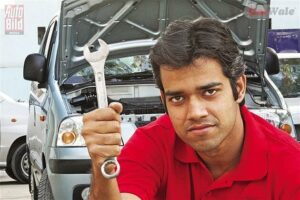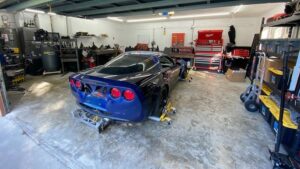Caring for your car is an integral part of adulting. By performing some simple maintenance tasks regularly, these essential maintenance duties will help keep both you and your vehicle in tiptop condition for years to come.
As soon as your vehicle is cool and parked on level ground, grab a rag and open up its hood. Locate and wipe down the oil dipstick before inspecting its level.
1. Change the Oil
Many are wary of changing their own oil, yet it is one of the most vital DIY tasks you can undertake. Not only will it save money but it will ensure that your vehicle remains well lubricated throughout its lifespan.
To change your oil yourself, you will require a drain pan, jack stands and either a floor jack or purpose-made steel ramps – plus tools such as wrenches, oil filters, funnels and drain plugs.
Check your owner’s manual for specific maintenance instructions, but generally speaking it’s wise to replace your oil every 5,000 to 7,500 miles and regularly monitor changes in its color, consistency and level. If any issues arise such as hard shifts in transmission or engine stalling then visit a mechanic for repairs as soon as possible.
2. Change the Filter
At one time, drivers invested time and effort into performing their own maintenance on their car themselves and saved considerable money doing it themselves. While we now leave that task up to mechanics or service intervals, there are still a few small tasks you can perform yourself that could save money in repairs.
Change the filter frequently and for optimal performance to improve engine performance, gas mileage and extend car lifespan. Also important are checks and topping up of essential fluids like brake fluid, engine oil, power steering fluid and windshield washer fluid on an ongoing basis; doing this only takes minutes while helping prevent overheating or component damage.
3. Check the Tires
Unworn or bald tires can turn an ordinary trip to the grocery store into an unexpected risk, so it is crucial that you learn how to check tread depth independently in order to replace tires as soon as necessary.
Engine oil, transmission fluid, coolant, power steering fluid and windshield wiper fluid are among the essential liquids to keep in good condition for maximum performance. Most come equipped with an easy-to-use dipstick that makes monitoring levels quick and straightforward.
Tire pressure gauges can be invaluable tools in any vehicle, and using a penny to determine when your tires require replacement can also be helpful – stick one in the tread and see whether all of Lincoln’s head can be seen; otherwise it’s time for replacement tires.
4. Change the Wiper Blades
Wiper blades on your car provide crucial visibility enhancement. Over time, however, they may become worn and frail; when that occurs it is essential that they are replaced to ensure optimal visibility is not hampered.
To switch out wiper blades, first unlatch and unhook the old ones by squeezing each end’s lock pin or tab (needle-nose pliers may help release stubborn ones), before fitting your new wiper adapter and pushing down until you hear or feel it click in place.
Since wiper blades can be rather pricey, it’s wise to keep a spare set in your trunk in case any need arises for replacing them quickly when necessary. Doing this easy maintenance task regularly could save money down the line!
5. Change the Battery
Car batteries are at the core of every vehicle, providing power for sensors, lights and engine operation as well as serving as backup in case of an electrical short or failing alternator.
Proper battery maintenance can extend its lifespan significantly. Keep an eye out for signs that suggest your battery might be dying, such as slow engine crank or dim headlights.
Before performing any battery maintenance or repair, ensure it has been turned off and cooled down. Since you will be dealing with acid, it’s essential to protect yourself and those nearby from being exposed to its damaging effects.
Before popping open the hood, wear some insulated work gloves and safety goggles to protect yourself. Locate your battery – usually located near one of the front corners in the engine bay – before disconnecting its negative cable first.
6. Check the Lights
Make sure your lights are functioning as intended before getting behind the wheel. Maintaining good lights allows you to drive safely and be noticed by other drivers on the road; having functioning headlights, tail lights, and indicators will help avoid fines or accidents caused by poor visibility.
As an easy way to quickly assess the lights in your car, park it about 10 feet from a wall or garage door and switch on both headlights and daytime running lights simultaneously. They should cast two areas of light with matching brightness and patterns on the wall – if either doesn’t work as it should it is easy enough to replace bulbs for one of them! You might also take this opportunity to check indicator lights (turn signals).
7. Change the Brakes
At the outset of any brake job, it is necessary to gather together the tools that will best serve you for that vehicle. Most how-to guides advise using a lug wrench, c-clamp clamp and possibly caliper spreader tool as essential items; don’t forget a can of brake fluid!
Simply raise your car with a jack using the points outlined in your owner’s manual, ensuring jack stands are underneath each tire for extra stability. Next, loosen and remove any necessary lug nuts before pulling out your wheel.
Once the caliper has been taken apart, unravel its two slider bolts which hold it in place. If any are particularly stubborn use freeing oil to help loosen them; just be careful not to get any on your brake disc or pads! Once everything has been assembled reinstall the pads and support bracket on the rotor then reinsert all bolts. For added noise reduction apply brake quiet paste if required.


